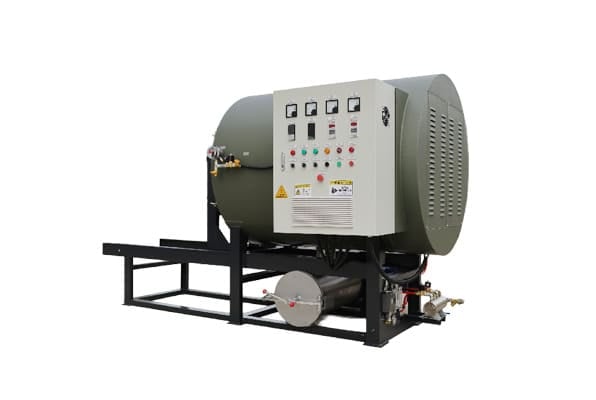Vacuum cleaning furnaces(Polymers) https://8ruiyan.com/en/all-vacuum-cleaning-furnaces/are essential for cleaning polymer residues from spinning components, filters, and more in chemical fiber and plastics industries. Yet, equipment managers often battle three persistent issues: incomplete cleaning, furnace blackening, and vacuum failures. These problems disrupt production schedules and inflate maintenance costs. This guide delivers actionable solutions to crush these challenges!

Challenge 1: Incomplete Cleaning – Lingering Residues?
Symptoms:
- Visible polymer residue on components
- Incomplete unclogging of microporous filters
- Abnormal pressure spikes during first post-cleaning use
Root Causes:
- Insufficient temperature/time: Polymers not reaching full pyrolysis temperature or inadequate dwell time.
- Low vacuum level: Pyrolysis byproducts not evacuated, causing “re-cooking.”
- “One-size-fits-all” process: Using identical curves for PET, PA, PP.
- Overloading: Restricted heat/flow due to overcrowded workload.
Solutions:
- Precise temperature control: Calibrate thermocouples. Set polymer-specific temperatures (e.g., PET: 450–500°C; PA6: 400–450°C). Extend dwell time (add 1–2 hrs for stubborn residues).
- Vacuum assurance: Achieve ≤10 Pa before heating (check pump oil, seals, valves).
- Customized recipes: Build dedicated process libraries (temp/time/vacuum/N₂ flow) per material.
- Smart loading: Maintain ≥50mm spacing between parts. Clean complex items in batches.
Challenge 2: Furnace Blackening – The Carbon Nightmare
Symptoms:
- Black carbon powder coating walls, racks, and parts
- Carbon buildup in vacuum pipes
- Post-cleaning part blackening requiring rework
Root Causes:
- Rapid heating: Polymers “smoldering” into carbon in O₂-deficient zones.
- Delayed vacuum: Oxygen residues causing incomplete combustion during ramp-up.
- Aşırı ısınma: Excessive temperatures carbonizing polymers.
- Premature opening: Ambient O₂ carbonizing hot parts.
- Silicone oil sabotage: Lubricants on components accelerating carbonization.
Solutions:
- Controlled ramp-up: Use step heating (e.g., 50°C/h) in 200–350°C (primary pyrolysis zone).
- Preemptive vacuum: Pull ≤10 Pa before heating starts. Verify pump speed/seals.
- Golden temperature: Optimize cleaning temp (avoid >550°C unless specified).
- Strict opening protocol: Open only at ≤80°C !
- Source control: Wipe silicone oils/greases from parts pre-cleaning.
Challenge 3: System Failures – Vacuum Collapse, Thermal Chaos & Slow Cooling
Symptoms:
- Vacuum stuck >50 Pa
- Doubled heat-up time, >20°C chamber gradient
- Cooling >10 hours delaying production
Root Causes:
| Failure Type | Key Culprits |
|---|---|
| Vacuum failure | Emulsified pump oil, degraded seals, valve leaks, clogged filters, wet parts |
| Temperature faults | Broken heaters, faulty thermocouples, SSR/contactor failure, controller error, insulation damage |
| Slow cooling | Cooling water issues (pressure/temp/scale), overloaded furnace |
Solutions:
- Vacuum system maintenance:
- Monthly pump oil checks (replace if milky). Quarterly oil changes.
- Critical! Leak-check all seals (door, valves, electrodes) with helium/soap solution.
- Clean/replace vacuum line filters.
- Thermal system integrity:
- Measure heater resistance (balance phases). Replace broken elements.
- Calibrate thermocouples. Check for oxidized/loose terminals.
- Test SSR switching function.
- Cooling system optimization:
- Avoid loading >70% chamber volume.
🛡️ Ultimate Defense: Preventive Maintenance Checklist (Monthly!)
- Seal care: Clean door grooves, lubricate seals with silicone grease, inspect for cracks.
- Pump health: Check oil level/color (replace if milky/black). Listen for abnormal noise.
- Electrical safety: Tighten terminals. Verify heater insulation resistance.
- Instrument calibration: Cross-check furnace temp with reference thermocouple. Validate vacuum gauge.
- Chamber hygiene: Remove carbon dust. Maintain unobstructed gas flow.
Conclusion: Efficient Cleaning = Precision Process × Rigorous Maintenance
Vacuum cleaning furnaces (Polymers)aren’t “black boxes.” Defeating residue, carbon, and failures hinges on:
Understanding principles + Precision control + Preventive upkeep.
Act now:
- Inspect door seals for aging.
- Check vacuum pump oil clarity.
- Audit if processes match material specs.
Master these field-tested tactics to transform your vacuum furnace into a relentless production ally!
For further consultation, please contact our technical team for expert advice.
Whatsapp:86-19106101570
wechat:86-19106101570
email:nieyili@cnryan.com
